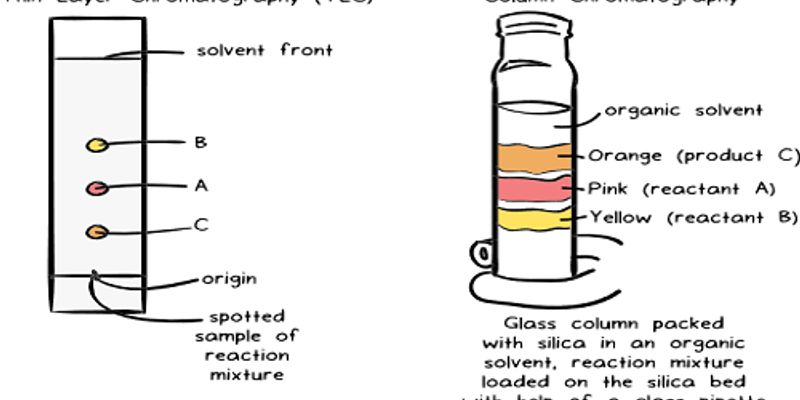Chromatography
Chromatography: an analytical technique commonly used for separating a mixture of chemical substances into its individual components, so that the individual components can be thoroughly analyzed. . The mixture is dissolved in a fluid called the mobile phase, which carries it through a structure holding another material called the stationary phase. The various constituents of the mixture travel at different speeds, causing them to separate. The separation is based on differential partitioning between the mobile and stationary phases. Subtle differences in a compound's partition coefficient result in differential retention on the stationary phase and thus affect the separation.
-
MAR 25, 2020 | 12:00 AMWith the passing of the 2018 Farm Bill legalizing hemp, farmers are allowed to grow hemp. Like any other agricultural crop, pesticides are applied to hemp plants to protect it from pests and...MAR 05, 2020 | 9:00 AMRecommendations for key factors in testing and diagnosis of H. pylori infections to include information on appropriate patients for H.pylori testing, current testing options, post treatment...FEB 14, 2020 | 10:00 AMDATE: February 14, 2020 TIME: 10:00am PT, 1:00pm ET Separation challenges arise in the lab on a daily basis and you rely on a broad analytical toolset to help solve them. In this presentatio...JAN 14, 2020 | 9:00 AMFecal elastase-1 – a biomarker for pancreatic exocrine insufficiency(EPI) continues to gain traction as an ideal biomarker for assessing EPI. This presentation will include a review of...OCT 24, 2019 | 10:30 AMSupercritical fluid chromatography (SFC) has historically been very effective for exacting difficult chiral separations, with an unmatched power in terms of enabling highly efficient enantios...OCT 24, 2019 | 6:00 AMChromatography is the first choice in separation technique for a wide selection of applications, across many fields, ranging from simple to highly complex extracts. The main rationale for it...OCT 22, 2019 | 9:00 AMDATE: October 22, 2019 TIME: 9:00am PDT, 12:00PM EDT...Speaker: Angela Bazigos , Kristeena Wright, PhD , Shweta NairSponsored By: Advanced InstrumentsOCT 10, 2019 | 1:30 PMMetastatic castration resistant prostate cancer (mCRPC) refractory to secondary hormonal treatments such as enzalutamide or abiraterone acetate are the most lethal of prostate cancers. In thi...Speaker: Tian Zhang, MD, MHSOCT 10, 2019 | 12:00 PMTumor mutational burden (TMB) is an emerging biomarker that correlates with response to immunotherapeutic agents, such as checkpoint inhibitors. Recent studies indicate that a high mutation l...Speaker: Ravindra Kolhe, MD, PhDOCT 10, 2019 | 10:30 AMOsteosarcoma (OS) is the most common bone tumor in pediatric and adolescent/young adult patients. Over the past three decades, significant improvements in the survival rates or therapeutic ap...Speaker: Troy McEachron, PhDPresented at: Cancer Research & Oncology Week Virtual Event Series 2019
Sponsored By: NanoString TechnologiesOCT 10, 2019 | 10:30 AMAccumulation of structural variations (SVs) across the genome is a known trigger factor for oncogenesis. Structural mutations have been clearly implicated in a number of cancers, most notably...Speaker: Sven Bocklandt, PhDOCT 10, 2019 | 9:00 AMCopy-number alterations and chromosomal translocations are widespread in cancer and frequently causing oncogenic mutations that drive tumorigenesis and therapy resistance. Despite their preva...Speaker: Cheng-Zhong Zhang, PhDOCT 10, 2019 | 9:00 AMBlockade of CTLA-4 and PD-1, members of the B7/CD28 family, have proven to be the most successful cancer immunotherapies to date. While the current therapeutic focus remains on B7/CD28 family...Speaker: Anthony Persen, PhDPresented at: Cancer Research & Oncology Week Virtual Event Series 2019
Sponsored By: ACD - A Bio-Techne BrandOCT 09, 2019 | 12:00 PMThe introduction of robot-assisted surgical technology into urological practice, has introduced new horizons for reducing the morbidity and enhancing the efficacy of surgery. Open radical cys...Speaker: Khurshid Guru, MDOCT 09, 2019 | 10:30 AMA subset of women with ovarian cancer will present with an apparently isolated adnexal mass. Many of these women will have early stage ovarian cancer with a relatively good prognosis. Unfortu...Speaker: Mitchel Hoffman, MDMAY 30, 2019 | 1:30 PMTissues in the body are wonderfully organized, with specific arrangements of cells, extracellular matrix, secreted molecules, and fluid flow that synergize that create emergent functions. How...Speaker: Rebecca Pompano, PhDMAY 30, 2019 | 12:00 PMWith growing standards of patient care, clinical testing laboratory across the world are forced to change the way they manage their laboratory operations. More focus is now given to automatio...Speaker: Shonali Paul, MBAMAY 30, 2019 | 12:00 PMThe attractiveness of 3D printing technology in the microfluidic field is growing, specifically stereolithographic (SLA) type 3D printers, owing to their low cost, versatility, fast and easy...MAY 30, 2019 | 10:30 AMComputer vision (CV) has seen rapid growth in many industries, including the life sciences with high-content cell imaging and phenotypic assays. However, many biomolecular and cellular assay...MAY 30, 2019 | 9:00 AMIn this seminar, Dr Elvira will talk about the use of droplet microfluidic technologies for drug discovery. Initially, she will discuss the fundamental concepts of droplet microfluidic techno...Speaker: Katherine Elvira, MSci, PhD, ARCSMAY 30, 2019 | 7:30 AMThe ultimate limits of diagnostics in biology are the “quantum” units that convey information, e.g. single nucleic acids, proteins, and cells. Microfluidics has emerged as a power...Speaker: Dino Di Carlo, Ph.D.MAY 30, 2019 | 6:00 AMOncologists have many options when tasked with treating a patient’s cancer. Unfortunately, many cancer drugs and therapies come with potentially debilitating side effects. As such, it i...MAR 28, 2019 | 1:30 PMThe world is filled with harmful pathogens that increasingly threaten the safety of our cannabis, food and beverages. And yet, testing labs still rely on the Petri dishes scientists invented...MAR 28, 2019 | 1:30 PMCannabis prohibition has been prevalent since the 1930’s and has had a dramatic negative impact on patients, veterans and small business owners. As a small business owner serving patien...
MAR 25, 2020 | 12:00 AM
With the passing of the 2018 Farm Bill legalizing hemp, farmers are allowed to grow hemp. Like any other agricultural crop, pesticides are applied to hemp plants to protect it from pests and...
MAR 05, 2020 | 9:00 AM
Recommendations for key factors in testing and diagnosis of H. pylori infections to include information on appropriate patients for H.pylori testing, current testing options, post treatment...
FEB 14, 2020 | 10:00 AM
DATE: February 14, 2020 TIME: 10:00am PT, 1:00pm ET Separation challenges arise in the lab on a daily basis and you rely on a broad analytical toolset to help solve them. In this presentatio...
JAN 14, 2020 | 9:00 AM
Fecal elastase-1 – a biomarker for pancreatic exocrine insufficiency(EPI) continues to gain traction as an ideal biomarker for assessing EPI. This presentation will include a review of...
OCT 24, 2019 | 10:30 AM
Supercritical fluid chromatography (SFC) has historically been very effective for exacting difficult chiral separations, with an unmatched power in terms of enabling highly efficient enantios...
OCT 24, 2019 | 6:00 AM
Chromatography is the first choice in separation technique for a wide selection of applications, across many fields, ranging from simple to highly complex extracts. The main rationale for it...
OCT 22, 2019 | 9:00 AM
DATE: October 22, 2019 TIME: 9:00am PDT, 12:00PM EDT...
Speaker:
Angela Bazigos
, Kristeena Wright, PhD
, Shweta Nair
Sponsored By: Advanced Instruments
OCT 10, 2019 | 1:30 PM
Metastatic castration resistant prostate cancer (mCRPC) refractory to secondary hormonal treatments such as enzalutamide or abiraterone acetate are the most lethal of prostate cancers. In thi...
Speaker:
Tian Zhang, MD, MHS
OCT 10, 2019 | 12:00 PM
Tumor mutational burden (TMB) is an emerging biomarker that correlates with response to immunotherapeutic agents, such as checkpoint inhibitors. Recent studies indicate that a high mutation l...
Speaker:
Ravindra Kolhe, MD, PhD
OCT 10, 2019 | 10:30 AM
Osteosarcoma (OS) is the most common bone tumor in pediatric and adolescent/young adult patients. Over the past three decades, significant improvements in the survival rates or therapeutic ap...
Speaker:
Troy McEachron, PhD
Presented at: Cancer Research & Oncology Week Virtual Event Series 2019
Sponsored By: NanoString Technologies
Sponsored By: NanoString Technologies
OCT 10, 2019 | 10:30 AM
Accumulation of structural variations (SVs) across the genome is a known trigger factor for oncogenesis. Structural mutations have been clearly implicated in a number of cancers, most notably...
Speaker:
Sven Bocklandt, PhD
OCT 10, 2019 | 9:00 AM
Copy-number alterations and chromosomal translocations are widespread in cancer and frequently causing oncogenic mutations that drive tumorigenesis and therapy resistance. Despite their preva...
Speaker:
Cheng-Zhong Zhang, PhD
OCT 10, 2019 | 9:00 AM
Blockade of CTLA-4 and PD-1, members of the B7/CD28 family, have proven to be the most successful cancer immunotherapies to date. While the current therapeutic focus remains on B7/CD28 family...
Speaker:
Anthony Persen, PhD
Presented at: Cancer Research & Oncology Week Virtual Event Series 2019
Sponsored By: ACD - A Bio-Techne Brand
Sponsored By: ACD - A Bio-Techne Brand
OCT 09, 2019 | 12:00 PM
The introduction of robot-assisted surgical technology into urological practice, has introduced new horizons for reducing the morbidity and enhancing the efficacy of surgery. Open radical cys...
Speaker:
Khurshid Guru, MD
OCT 09, 2019 | 10:30 AM
A subset of women with ovarian cancer will present with an apparently isolated adnexal mass. Many of these women will have early stage ovarian cancer with a relatively good prognosis. Unfortu...
Speaker:
Mitchel Hoffman, MD
MAY 30, 2019 | 1:30 PM
Tissues in the body are wonderfully organized, with specific arrangements of cells, extracellular matrix, secreted molecules, and fluid flow that synergize that create emergent functions. How...
Speaker:
Rebecca Pompano, PhD
MAY 30, 2019 | 12:00 PM
With growing standards of patient care, clinical testing laboratory across the world are forced to change the way they manage their laboratory operations. More focus is now given to automatio...
Speaker:
Shonali Paul, MBA
MAY 30, 2019 | 12:00 PM
The attractiveness of 3D printing technology in the microfluidic field is growing, specifically stereolithographic (SLA) type 3D printers, owing to their low cost, versatility, fast and easy...
MAY 30, 2019 | 10:30 AM
Computer vision (CV) has seen rapid growth in many industries, including the life sciences with high-content cell imaging and phenotypic assays. However, many biomolecular and cellular assay...
MAY 30, 2019 | 9:00 AM
In this seminar, Dr Elvira will talk about the use of droplet microfluidic technologies for drug discovery. Initially, she will discuss the fundamental concepts of droplet microfluidic techno...
Speaker:
Katherine Elvira, MSci, PhD, ARCS
MAY 30, 2019 | 7:30 AM
The ultimate limits of diagnostics in biology are the “quantum” units that convey information, e.g. single nucleic acids, proteins, and cells. Microfluidics has emerged as a power...
Speaker:
Dino Di Carlo, Ph.D.
MAY 30, 2019 | 6:00 AM
Oncologists have many options when tasked with treating a patient’s cancer. Unfortunately, many cancer drugs and therapies come with potentially debilitating side effects. As such, it i...
MAR 28, 2019 | 1:30 PM
The world is filled with harmful pathogens that increasingly threaten the safety of our cannabis, food and beverages. And yet, testing labs still rely on the Petri dishes scientists invented...
MAR 28, 2019 | 1:30 PM
Cannabis prohibition has been prevalent since the 1930’s and has had a dramatic negative impact on patients, veterans and small business owners. As a small business owner serving patien...
























